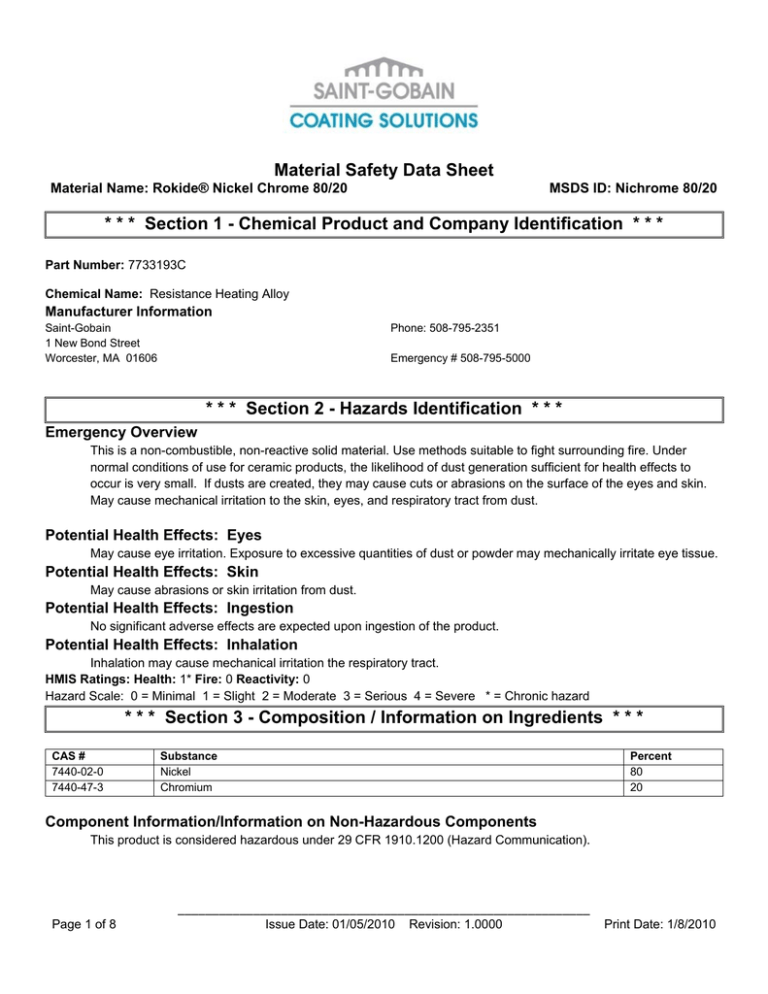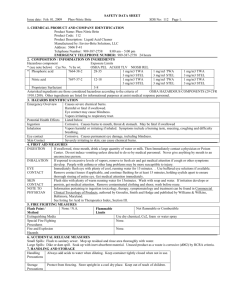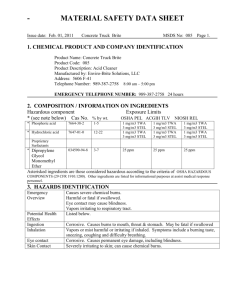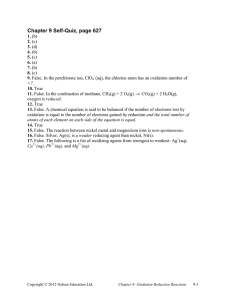Rokide® Nickel Chrome 80/20, MSDS, Saint
advertisement

Material Safety Data Sheet Material Name: Rokide® Nickel Chrome 80/20 MSDS ID: Nichrome 80/20 * * * Section 1 - Chemical Product and Company Identification * * * Part Number: 7733193C Chemical Name: Resistance Heating Alloy Manufacturer Information Saint-Gobain 1 New Bond Street Worcester, MA 01606 Phone: 508-795-2351 Emergency # 508-795-5000 * * * Section 2 - Hazards Identification * * * Emergency Overview This is a non-combustible, non-reactive solid material. Use methods suitable to fight surrounding fire. Under normal conditions of use for ceramic products, the likelihood of dust generation sufficient for health effects to occur is very small. If dusts are created, they may cause cuts or abrasions on the surface of the eyes and skin. May cause mechanical irritation to the skin, eyes, and respiratory tract from dust. Potential Health Effects: Eyes May cause eye irritation. Exposure to excessive quantities of dust or powder may mechanically irritate eye tissue. Potential Health Effects: Skin May cause abrasions or skin irritation from dust. Potential Health Effects: Ingestion No significant adverse effects are expected upon ingestion of the product. Potential Health Effects: Inhalation Inhalation may cause mechanical irritation the respiratory tract. HMIS Ratings: Health: 1* Fire: 0 Reactivity: 0 Hazard Scale: 0 = Minimal 1 = Slight 2 = Moderate 3 = Serious 4 = Severe * = Chronic hazard * * * Section 3 - Composition / Information on Ingredients * * * CAS # 7440-02-0 7440-47-3 Substance Nickel Chromium Percent 80 20 Component Information/Information on Non-Hazardous Components This product is considered hazardous under 29 CFR 1910.1200 (Hazard Communication). ____________________________________________________________ Page 1 of 8 Issue Date: 01/05/2010 Revision: 1.0000 Print Date: 1/8/2010 Material Safety Data Sheet Material Name: Rokide® Nickel Chrome 80/20 MSDS ID: Nichrome 80/20 * * * Section 4 - First Aid Measures * * * First Aid: Eyes Immediately flush eyes with water for at least 15 minutes, while holding eyelids open. Do not rub eyes. Get medical attention if irritation persists. First Aid: Skin Remove contaminated clothing. Wash area of contact thoroughly with soap and water. Do not rub or scratch exposed skin. If irritation persists, get medical attention. Wash contaminated clothing before reuse. First Aid: Ingestion Do not induce vomiting. If ingestion of a large amount does occur, seek medical attention. First Aid: Inhalation Move person to non-contaminated air. If symptoms persist, get medical attention. First Aid: Notes to Physician Treat symptomatically and supportively. For eye exposure, insure that eyes have been washed thoroughly. X-ray follow-up may be indicated for high inhalation exposures, especially in chronically exposed individuals with review for nodular opacities. A small population segment has been shown to be significantly more vulnerable to lung injury than the mean. * * * Section 5 - Fire Fighting Measures * * * General Fire Hazards See Section 9 for Flammability Properties. This material is not expected to be a fire hazard. Dust hazard exists under favoring conditions of small particle size. Dust accumulation from this product may present an explosion hazard in the presence of an ignition source. Hazardous Combustion Products Decomposition of this product may yield metallic oxides. Extinguishing Media Dry chemical - use dry powder for metal fires, gently spoon media onto fire. Do not disturb particles. Fire Fighting Equipment/Instructions Fire fighters should wear full-face, self contained breathing apparatus and impervious protective clothing. Fire fighters should avoid inhaling any combustion products. NFPA Ratings: Health: 1 Fire: 0 Reactivity: 0 Hazard Scale: 0 = Minimal 1 = Slight 2 = Moderate 3 = Serious 4 = Severe * * * Section 6 - Accidental Release Measures * * * Containment Procedures Ventilate area as necessary to reduce any airborne dusts to a safe level before entry unless personal protective equipment is adequate for protection. Clean-Up Procedures Avoid the generation of dusts during clean-up. If sweeping of a contaminated area is necessary, use a dust suppressant agent. If available, use an industrial vacuum cleaner with HEPA exhaust filtration to clean up remaining particulate spilled material. Dispose of in accordance with all federal, state, and local disposal regulations. ____________________________________________________________ Page 2 of 8 Issue Date: 01/05/2010 Revision: 1.0000 Print Date: 1/8/2010 Material Safety Data Sheet Material Name: Rokide® Nickel Chrome 80/20 MSDS ID: Nichrome 80/20 Evacuation Procedures None necessary. Special Procedures Use personal safety, handling, and exposure recommendations described in Section 8 of this Material Safety Data Sheet. * * * Section 7 - Handling and Storage * * * Handling Procedures Take every reasonable measure to limit dust/fume concentrations and minimize exposure to dust/fumes. Storage Procedures Store in a cool, dry, well-ventilated area. Guard against dust/fume accumulation of this material. Keep the container tightly closed. * * * Section 8 - Exposure Controls / Personal Protection * * * A: Component Exposure Limits Nickel (7440-02-0) ACGIH: OSHA: NIOSH: 1.5 mg/m3 TWA (inhalable fraction) 1 mg/m3 TWA 0.015 mg/m3 TWA Chromium (7440-47-3) ACGIH: OSHA: NIOSH: 0.5 mg/m3 TWA 1 mg/m3 TWA 0.5 mg/m3 TWA B: Component Exposure Limits Consult local authorities for acceptable exposure limits. Nickel (7440-02-0) ACGIH: OSHA: NIOSH: Alberta: British Columbia: Manitoba: New Brunswick: NW Territories: Nova Scotia: Nunavut: Ontario: Quebec: Saskatchewan: Yukon: 1.5 mg/m3 TWA (inhalable fraction) 1 mg/m3 TWA 0.015 mg/m3 TWA 1.5 mg/m3 TWA 0.05 mg/m3 TWA 1.5 mg/m3 TWA (inhalable fraction) 1 mg/m3 TWA 1 mg/m3 TWA 2 mg/m3 STEL 1.5 mg/m3 TWA (inhalable fraction) 1 mg/m3 TWA 2 mg/m3 STEL 1 mg/m3 TWAEV (inhalable) 1 mg/m3 TWAEV 1.5 mg/m3 TWA (inhalable fraction) 3 mg/m3 STEL (inhalable fraction) 1 mg/m3 TWA 3 mg/m3 STEL ____________________________________________________________ Page 3 of 8 Issue Date: 01/05/2010 Revision: 1.0000 Print Date: 1/8/2010 Material Safety Data Sheet Material Name: Rokide® Nickel Chrome 80/20 MSDS ID: Nichrome 80/20 Chromium (7440-47-3) ACGIH: OSHA: NIOSH: Alberta: British Columbia: Manitoba: New Brunswick: NW Territories: Nova Scotia: Nunavut: Ontario: Quebec: Saskatchewan: Yukon: 0.5 mg/m3 TWA 1 mg/m3 TWA 0.5 mg/m3 TWA 0.5 mg/m3 TWA 0.5 mg/m3 TWA 0.5 mg/m3 TWA 0.5 mg/m3 TWA 0.5 mg/m3 TWA 1.5 mg/m3 STEL 0.5 mg/m3 TWA 0.5 mg/m3 TWA 1.5 mg/m3 STEL 0.5 mg/m3 TWAEV 0.5 mg/m3 TWAEV 0.5 mg/m3 TWA 1.5 mg/m3 STEL 0.1 mg/m3 TWA 3.0 mg/m3 STEL Engineering Controls Ventilation should effectively remove and prevent buildup of any dust generated from the handling of this product. Local exhaust ventilation is recommended when generating excessive levels of airborne dust or vapors from handling or thermal processing. Use a dust suppressant agent as needed. PERSONAL PROTECTIVE EQUIPMENT Personal Protective Equipment: Eyes/Face Wear safety glasses or chemical goggles to reduce eye contact with dust. Personal Protective Equipment: Skin Wear gloves and protective clothing to prevent skin contact. Use good personal hygiene. Showering and changing into clean clothing after work is strongly recommended. Personal Protective Equipment: Respiratory If ventilation is not sufficient to effectively prevent buildup of dust, appropriate NIOSH respiratory protection must be provided. Personal Protective Equipment: General Eye wash fountain is recommended. * * * Section 9 - Physical & Chemical Properties * * * Appearance: Physical State: Vapor Pressure: Boiling Point: Solubility in Water: Flash Point: Lower Flammability Limit: Auto Ignition Temp: Odor: pH: Vapor Density: Melting Point: Specific Gravity: Flash Point Method: Upper Flammability Limit: Solid metal rod Solid Not applicable Not applicable None Not applicable Not applicable Not applicable Not available Not applicable Not applicable 1850°C 4.0 Not applicable Not applicable ____________________________________________________________ Page 4 of 8 Issue Date: 01/05/2010 Revision: 1.0000 Print Date: 1/8/2010 Material Safety Data Sheet Material Name: Rokide® Nickel Chrome 80/20 MSDS ID: Nichrome 80/20 * * * Section 10 - Chemical Stability & Reactivity Information * * * Chemical Stability This is a stable material. Chemical Stability: Conditions to Avoid Avoid dispersion of dust in air. Avoid incompatible materials. Incompatibility Inert materials. Hazardous Decomposition Decomposition of this product may yield metallic oxides. Possibility of Hazardous Reactions Will not occur. * * * Section 11 - Toxicological Information * * * Acute Dose Effects A: General Product Information This product may cause mechanical eye, skin, and respiratory irritation. May cause abrasion to the eyes and skin. This product may cause metal fume fever with resulting flu-like symptoms. B: Component Analysis - LD50/LC50 Nickel (7440-02-0) Oral LD50 Rat >9000 mg/kg Repeated Dose Effects Adverse effects may result from long term exposure to welding fume, gases, or dusts. These include skin sensitization, neurological damage, and respiratory disease. Nickel overexposure can cause allergic skin reactions and allergic lung sensitization reactions producing an asthma-like condition. Inhalation can cause effects on the lungs such as bronchitis, emphysema and impaired function, as well as kidney damage. Ingestion can result in nausea, vomiting, diarrhea and abdominal cramps. Chronic overexposure during nickel production has been shown to cause lung and nasal cavity cancers in workers; these effects are directly related to the degree of exposure. The compounds associated with the production environment included metallic nickel, nickel oxides and nickel sulfides. Workplaces other than those involved with mining, refining and alloy manufacture have not been studied. Asthma induced by occupational exposure to nickel has been documented. The asthma can result from either primary irritation or from an allergic response. Contact dermatitis in workers exposed to nickel compounds is one of the most prevalent effects of nickel exposure. Chromium III, the naturally occurring form, has low toxicity while chromium VI is highly toxic due to strong oxidation characteristics and permeability through biological membranes. Excessive exposure to chromium VI can produce allergic skin sensitization reactions and severe nasal irritation, scarring and damage to the lungs, liver and kidney damage. Industrial exposure to chromium may cause dermatitis, skin ulcers, perforation of the nasal septum, as well as cancers of the lungs, nasal cavity and paranasal sinuses. ____________________________________________________________ Page 5 of 8 Issue Date: 01/05/2010 Revision: 1.0000 Print Date: 1/8/2010 Material Safety Data Sheet Material Name: Rokide® Nickel Chrome 80/20 MSDS ID: Nichrome 80/20 Carcinogenicity A: General Product Information The carcinogenic effect of nickel has been well documented in occupationally exposed nickel refinery workers. Lung and nasal cancers were the predominant forms of cancer in the exposed workers. In experimental animals injection of nickel produced injection site tumors although some of these tumors metastasized. Upon inhalation of nickel, lymphosarcomas were observed in mice and aveolar carcinomas in guinea pigs. B: Component Carcinogenicity Nickel (7440-02-0) ACGIH: NIOSH: NTP: IARC: A5 - Not Suspected as a Human Carcinogen potential occupational carcinogen Reasonably Anticipated To Be A Human Carcinogen (Possible Select Carcinogen) Monograph 49 [1990]; Supplement 7 [1987] (Group 2B (possibly carcinogenic to humans)) Chromium (7440-47-3) ACGIH: IARC: A4 - Not Classifiable as a Human Carcinogen Monograph 49 [1990] (listed under Chromium and Chromium compounds); Supplement 7 [1987] (Group 3 (not classifiable)) * * * Section 12 - Ecological Information * * * Ecotoxicity A: General Product Information No information available for the product. B: Component Analysis - Ecotoxicity - Aquatic Toxicity Nickel (7440-02-0) Test & Species Conditions 96 Hr LC50 Brachydanio rerio 96 Hr LC50 Cyprinus carpio 96 Hr LC50 Cyprinus carpio 72 Hr EC50 Pseudokirchneriella subcapitata 96 Hr EC50 Pseudokirchneriella subcapitata 48 Hr EC50 Daphnia magna 48 Hr EC50 Daphnia magna >100 mg/L 1.3 mg/L 10.4 mg/L 0.18 mg/L 0.174 - 0.311 mg/L >100 mg/L 1 mg/L Semi-static Static Static Static * * * Section 13 - Disposal Considerations * * * US EPA Waste Number & Descriptions A: General Product Information Dispose of waste material according to Local, State, Federal, and Provincial Environmental Regulations. B: Component Waste Numbers Chromium (7440-47-3) RCRA: 5.0 mg/L regulatory level Disposal Instructions Clean up and dispose of waste in accordance with all federal, state, and local environmental regulations. See Section 7 for Handling Procedures. See Section 8 for Personal Protective Equipment recommendations. ____________________________________________________________ Page 6 of 8 Issue Date: 01/05/2010 Revision: 1.0000 Print Date: 1/8/2010 Material Safety Data Sheet Material Name: Rokide® Nickel Chrome 80/20 MSDS ID: Nichrome 80/20 * * * Section 14 - Transportation Information * * * DOT Information: Shipping Name: Not regulated as a hazardous material. TDG Information: Shipping Name: Not regulated as a dangerous good. * * * Section 15 - Regulatory Information * * * US Federal Regulations A: General Product Information Components of this product have been checked against the non-confidential TSCA inventory by CAS Registry Number. Components not identified on this non-confidential inventory are exempt from listing (i.e. as polymers) or are listed on the confidential inventory as declared by the supplier. B: Component Analysis This material contains one or more of the following chemicals required to be identified under SARA Section 302 (40 CFR 355 Appendix A), SARA Section 313 (40 CFR 372.65) and/or CERCLA (40 CFR 302.4). Nickel (7440-02-0) SARA 313: CERCLA: 0.1 % de minimis concentration 100 lb final RQ (no reporting of releases of this hazardous substance is required if the diameter of the pieces of the solid metal released is larger than 100 micrometers); 45.4 kg final RQ (no reporting of releases of this hazardous substance is required if the diameter of the pieces of the solid metal released is larger than 100 micrometers) Chromium (7440-47-3) SARA 313: CERCLA: 1.0 % de minimis concentration 5000 lb final RQ (no reporting of releases of this hazardous substance is required if the diameter of the pieces of the solid metal released is larger than 100 micrometers); 2270 kg final RQ (no reporting of releases of this hazardous substance is required if the diameter of the pieces of the solid metal released is larger than 100 micrometers) Acute Health: Yes Chronic Health: Yes Fire: No Pressure: No Reactive: No State Regulations A: General Product Information Other state regulations may apply. Check individual state requirements. B: Component Analysis - State The following components appear on one or more of the following state hazardous substances lists: Component Nickel Chromium CAS 7440-02-0 7440-47-3 CA Yes Yes MA Yes Yes MN Yes Yes NJ Yes Yes PA Yes Yes RI Yes Yes The following statement(s) are provided under the California Safe Drinking Water and Toxic Enforcement Act of 1986 (Proposition 65): WARNING! This product contains a chemical known to the state of California to cause cancer. ____________________________________________________________ Page 7 of 8 Issue Date: 01/05/2010 Revision: 1.0000 Print Date: 1/8/2010 Material Safety Data Sheet Material Name: Rokide® Nickel Chrome 80/20 MSDS ID: Nichrome 80/20 Component Analysis - WHMIS IDL The following components are identified under the Canadian Hazardous Products Act Ingredient Disclosure List: CAS # Minimum Concentration Substance Nickel Chromium 7440-02-0 7440-47-3 0.1 % 0.1 % Additional Regulatory Information A: General Product Information No additional information available. B: Component Analysis - Inventory Substance Nickel Chromium CAS # 7440-02-0 7440-47-3 TSCA Yes Yes CAN DSL DSL EEC EINECS EINECS * * * Section 16 - Other Information * * * Other Information The information and recommendations set forth herein are taken from sources believed to be accurate as to the data hereof; however, Saint-Gobain Coatings Solution makes no warranty with respect to the accuracy of the information or the suitability of the recommendations and assures no liability to any user thereof. Key/Legend ACGIH = American Conference of Governmental Industrial Hygienists; CAS = Chemical Abstracts Service; CERCLA = Comprehensive Environmental Response, Compensation, and Liability Act; CFR = Code of Federal Regulations; CPR = Controlled Products Regulations; DOT = Department of Transportation; DSL = Domestic Substances List; EINECS = European Inventory of Existing Commercial Chemical Substances; EPA = Environmental Protection Agency; IARC = International Agency for Research on Cancer; IATA = International Air Transport Association; mg/Kg = milligrams per Kilogram; mg/L = milligrams per Liter; mg/m3 = milligrams per Cubic Meter; MSHA = Mine Safety and Health Administration; NA = Not Applicable or Not Available; NIOSH = National Institute for Occupational Safety and Health; NJTSR = New Jersey Trade Secret Registry; NTP = National Toxicology Program; OSHA = Occupational Safety and Health Administration; SARA = Superfund Amendments and Reauthorization Act; STEL = Short Term Exposure Limit; TDG = Transport Dangerous Goods; TSCA = Toxic Substances Control Act; WHMIS = Workplace Hazardous Materials Information System. End of Sheet NICHROME 80/20 ____________________________________________________________ Page 8 of 8 Issue Date: 01/05/2010 Revision: 1.0000 Print Date: 1/8/2010



